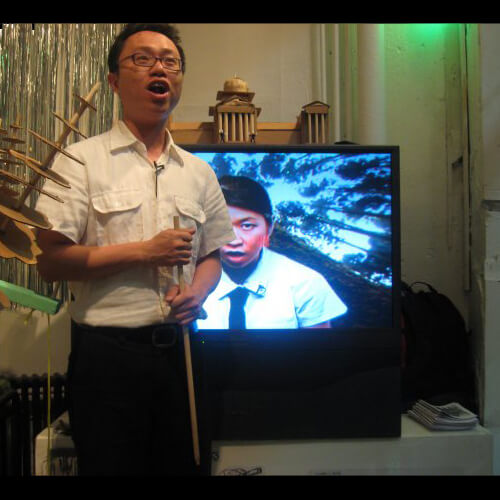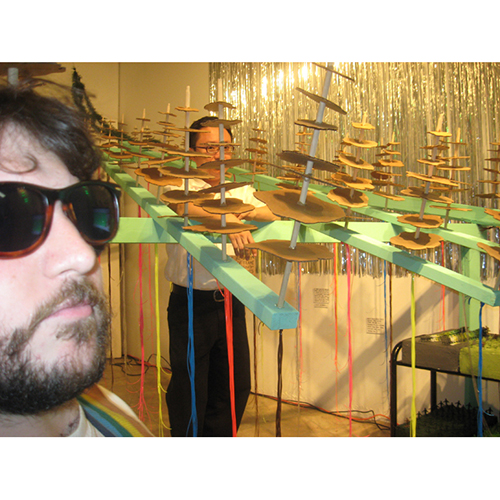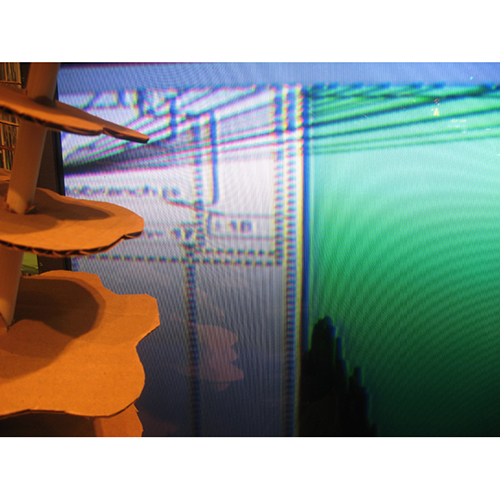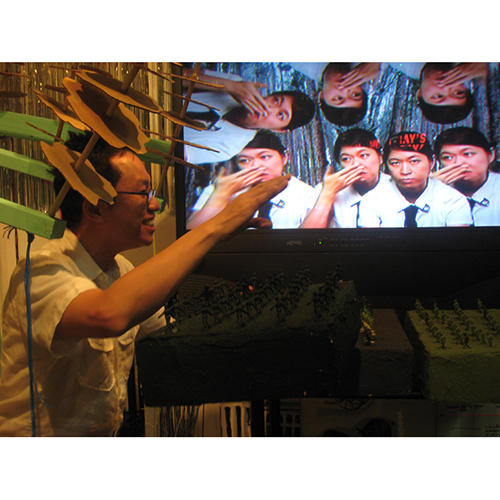Performances nightly October 13-25, 2008 at 7pm, 37th Street in Manhattan.
Installation open 10am-7pm, with live software "Pine Thumbs;" in the moment weather and street sound is filtered through software to create 'rooted' music that grows on itself. Tours of the museum performed by Herbie Go and video avatar of Chiasui Chen.
A collaboration between Chiasui Chen (performance on video, translation into Mandarin and Taiwanese), Esther Neff (text supervisor, director, installation fabrication), Brian McCorkle (software, songs), Shawna Ferrato (fabrication assistance and prop-making), and Herbie Go (tour performer, translation in Tagolog). Installation/performance uses silviculture (agroforestry) and its history in Taiwan and the Phillippines as a meta-phor for colonization, immigration, and cultural identity. Roots, rows, production, and their implications are discussed in a museum tour video in Mandarin and English and live museum "volunteer" Herbie Go. Cardboard pine trees, pine air fresheners (Taiwan produces the world's artificial Christmas trees), bronze buffaloes, silviculture technique displays, and heeeeerbiiiiiiciiiiides invites visitors to crawl beneath a mint green pine frame and "immerse themselves in (neon lanyard) roots."
NOTES:
A few tree-derived products that are major exports of Taiwan: Furniture, medicines, clothing chemicals, plastic products, lumber, artificial Christmas trees.
A few tree-derived products that are major exports of The Philippines: carpets, clothing, furniture, fruit, jewelry, shoes, hats, baskets, foods with cellulose.
What Wikipedia says about “Culture of Taiwan”
What Wikipedia says about "Culture of the Philippines"
What Wikipedia says about “Society of the United States”
What is silviculture? The science of forestry contains several disciplines, just as human sciences includes anthropology, sociology, political science, psychology, ethnography, history, etc. Silvics, or silviculture, is one discipline of forestry. Like the human science disciplines, it bleeds on all edges into its surrounding disciplines. “Silviculture” as a term, is usually used to describe sustainable, more environmentally compatible techniques of agroforestry in existing forests (selection cutting, thinning, etc) however, environmentally devastating practices such as clear cutting and chemical fertilization are often also applied to existing “cultured” forests as a part of silvic methods.
Silvic methods may also include regeneration, or the re-planting of cleared ground for “moral” purposes ofreturning lands to their “natural” state, or for other purposes such as wind, sound, or erosion control, or for the creation of parks and habitats for wildlife.
INDEX OF TERMS:
Tree: a woody, single-stemmed, self-supporting perennial (lives more than one year without dying and re-sprouting) at least 15 feet tall and 3 inches in diameter.
A.) Deciduous trees have more secondary branches and lose their leaves seasonally.
B.) Conifers (also referred to as “evergreens”) are cone bearing and do not lose their needles which they have instead of leaves, also have less supportive secondary branches. Also known as pine trees.
(Note: there are exceptions to these definitions of coniferous and deciduous trees, just as duckbilled platypi lay eggs yet remain mammals)
Roots: as well as absorbing nutrients and water for the body, roots fix the rest of body to the ground or aerial base, assist cell growth through a cykotinin synthesis, and store patterns for growth.
Canopy: in deciduous (leafed) trees, the dense layer formed by the tops (or “crowns”) of trees. “Closed canopy” means all of the treetops are interwoven, blocking most sunlight and thereby preventing undergrowth or seedlings from sprouting on the forest floor.
Sapling: a small, young tree. Younger trees are seedlings, or transplants, alternatively “starts” or "sticks."
Community: Plant 'communities' are collections of different plant species that occur with one another under similar conditions (ecological, geological, hydrological, and geographical). Typically, communities are specific collections of organisms that interact with one another and the environment and are recognized in other locations in the world.




